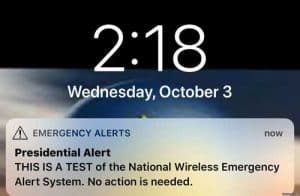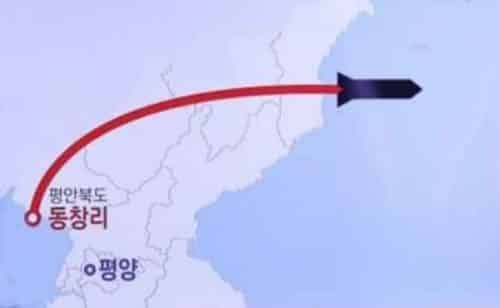
WHITE HOUSE — Americans across the country heard their cellphones simultaneously sound an alarm on Wednesday as the federal government tested, for the first time, its presidential wireless emergency alert system.
Authorities assured the public in advance this was only a test, but in a real national emergency — such as the detection of an incoming ballistic missile, a coordinated terrorist attack or even a cataclysmic volcanic eruption — the same tone would be heard.
Those with their mobile devices switched on at 2:18 p.m. EDT (18:18 GMT) heard a unique loud tone while the device simultaneously vibrated. A message box popped up on screens, informing: “THIS IS A TEST of the National Wireless Emergency Alert System. No action is needed.”
Two minutes later, those watching broadcast and cable television or listening to AM and FM radio stations were also likely see or hear a similar alert, interrupting programming for about 1 minute, as part of the Integrated Public Alert and Warning System (IPAWS) combined national test of the Wireless Emergency Alerts (WEA) and Emergency Alert System.
The exercise had been scheduled for September 20, but was delayed until October 3 due to the impact of Hurricane Florence in North and South Carolina.
Mobile devices targeted
It was estimated by FEMA that at least 75 percent of targeted mobile devices – about 225 million cellphones in the United States — would successfully sound the alert within a 30-minute period – the test is being conducted, in part, to determine just how expansive its reach.
“If you are engaged in a phone call and are on there for 31 minutes, the emergency alert is not going to interrupt that call,” a FEMA official said, adding that devices engaged in “active data sessions” would also not be interrupted by the alert.
Since 2012, government agencies have issued regional alerts more than 36,000 times for severe weather warnings and missing abducted children (the latter known as AMBER Alerts).
Wednesday’s alert, however, was the first national alarm sounded by the Federal Emergency Management Agency and the Federal Communications Commission under an act of Congress approved in 2006 during the George W. Bush presidential administration. The regional WEA alerts began during the administration of Barack Obama.
On social media, many expressed unease with the test of the new presidential messaging system because there is no way to opt out.
“There is no opting out of the presidential alert, which would only be used in a national emergency,” confirms a senior FEMA official. Even if there was a way to decline receiving the messages that would not be recommended for cellphone users as “they would prevent themselves from receiving critical life-saving information.”
Others worry that President Donald Trump, a very active user of Twitter, would abuse the system and force the public to receive messages from him.
“The president will not be directly triggering this alert,” the FEMA official explained on a briefing conference call on Tuesday.
[content id=”79272″]
VOA queried White House officials to determine whether the Trump’s cell phones also received the presidential alert, but they declined to comment, citing security concerns about his mobile devices.
Only for true national emergencies
Government officials are offering assurances that an actual alert would only be sounded for a true national emergency or other public peril, explaining that the law, protocols and procedures are well-established to prevent any president from ordering distribution of another type of message.
“You would not have a situation where any sitting president would just wake up one morning and attempt to send a personal message,” said the official speaking to reporters on condition of not being named. “The president would not originate this alert from his mobile device.”
Some remain unconvinced by those assurances.
A trio of New Yorkers filed a lawsuit in federal court last month to halt the nationwide test.
“I believe that for any public alert, people should be able to opt out,” one of the plaintiffs, Kristine Rakowsky, said. “We have a right to privacy and not having your phone turned into a loudspeaker like in North Korea.”
The Southern District of New York court docket indicates summons were issued to Trump and FEMA Director William “Brock” Long on September 26.
The motion for a preliminary injunction that would have halted the emergency test was denied Wednesday morning by Judge Katherine Polk Failla.
“We have a president who opts to use social media to address the public at large,” Rakowksy tells VOA. “And he has as a history of sending unhinged, false and biased messages on Twitter.”
Even if Trump was not the president, Rakowsky adds, she would still oppose the alert system out of concern that children could be traumatized by automatically receiving an alert they would not fully understand.
Like it or not, Rakowsky said she expected to hear Wednesday’s test alarm.
“I probably won’t have my cellphone turned off, because I have to pick up my son,” she said.
One of the other plaintiffs in the lawsuit, however, may be in the minority unable to receive the alert on Wednesday. Freelance photojournalist Jason B. Nicholas is hiking in the mountains of Vermont.
An email sent by VOA to him, requesting comment, generated an automatic reply: “Thanks for the email. I’m hiking somewhere out of communication range. I’ll be unavailable until Monday, Oct. 8.”
Source: VOA







